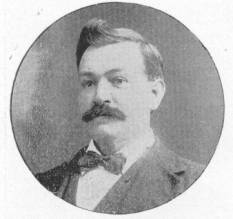J.R. Baldwin
|
He married Eliza Bruce, daughter of Jackson Bruce, a wealthy stock dealer near Jamestown, Moniteau Co., Missouri. To this marriage two children were born; a son Arthur and a daughter Zora Ethel. Arthur held a position at the Missouri Penitentiary. The family resided at 705 East McCarty Street.
Balkenhol, Jacob
Jacob Balkenhol, master roofer, was the fourth successive generation of his family to follow roofing as a business. Mr. Balkenhol was born in St. Louis July 8, 1888, and came to Jefferson City February 26, 1896. He grew up in the roofing business. While a boy his odd hours and vacations were spent on roofs. He graduated from the Jefferson City High School in 1907, married in 1915 and in 1919 went into partnership with his father in a general roofing business, specializing in slate and tile, waterproofing and flat roofings.
His father, Ferdinand Balkenhol, born in Westphalia, Germany, October 27, 1858, was active as a roofer until his death on May 19, 1924. Ferdinand Balkenhol was a foreman roofer at the age of sixteen. He was the son of Herman Balkenhol, a slate and tile roofer, who was also the son of a roofer. Ferdinand’s brother William, still in Germany, followed the same business. Ferdinand Balkenhol came to the United States in 1886 and located in St. Louis where he was recognized as an authority in his business having worked over a large part of Germany, Switzerland and France, where he made a study of methods in these countries.
Ferdinand Balkenhol in 1887 was married to Miss Marguerite Gausert, who was born in Germany December 26, 1861. They had two children, Jacob and Doctor E.M. Balkenhol of Davenport, Iowa.
Jacob Balkenhol was married June 30, 1915, to Miss Mathilda Gayer, daughter of P.W. and Dorothy Gayer. P.W. Gayer was a teacher and an expert with the microscope. Mrs. Balkenhol was an active worker in the Lutheran Church and in social service. Mr. and Mrs. Balkenhol had six children. Ferd G. and Jacob F. were associated with their father in the roofing business. The other children were Margareth, Ruth, Robert and Marie. At age eleven, Bob declared his ambition was to become an aviator. He felt roofing was too dangerous.
Rev. A.H. Barnes
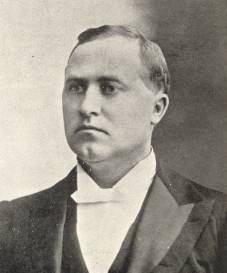 |
On June 11, 1890 he married Christine Schlotzhauer who at that time was in charge of the Musical Conservatory of Pilot Grove College. To this union three children were born: Nadine, Maurine and Arthur.
During the Spanish-American War, he served as Chaplain of the 6th Missouri. He was a member of the A.F. & A.M.; M.W.A.; Vice President of the Southwestern Annual Conference League, as well as serving as the Pastor of the M.E. Church South of Jefferson City. He and his wife made their home at the parsonage located at 419 East Main Street, Jefferson City.
G.C. Bassman
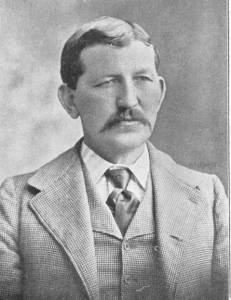 |
He followed farming until March, 1890 when he moved to Jefferson City. A year later he began his own business, leasing the Farmer’s Home of which he continued for three years. He then engaged successfully in farming for the next three years when he then formed a partnership with John M. Sommerer, purchasing the grocery business from Lawrence Wagner, now called Sommerer & Bassman. Mr. Bassman married Margaretta Sahr on September 30, 1879. To this union eight children were born: Frederick, the eldest, died in infancy; Hilda, Estella, Agnes, Otto, twins George and Oscar, and Sophia. The family made their home at 802 Jefferson Street, Jefferson City.
A. J. Bauer
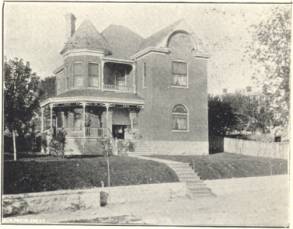
Gus Bauer’s Home – 621 East High Street
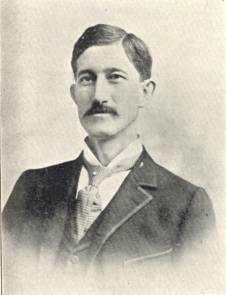 |
In April, 1891 he was elected City Collector on the Republican ticket where he enjoyed continuous re-election. He was also the Chairman of the Republican City Central Committee. He was a member of the Evangelical Central Lutheran Church; Secretary and Treasurer of the Wyaconda Lead and Zinc Mining Co.; as well as Secretary of the Home Building and Loan Association, all of Jefferson City.
On October 10, 1893 he married Laura E. Straub, daughter of Wendell Straub a cigar manufacturer of Jefferson City. To this union a son was born named Harold.
Franz W. Bauer
Much of the excellence of the product of the Capital Brewery was due to the skill of the brewmaster, Franz W. Bauer. Mr. Bauer learned his trade thoroughly as a youth in Germany, the land of his birth, where the brewing of good beer is one of the fine arts. He came to Jefferson City in the late 1800s at the request of Jacob F. Moerschel, for whom he had worked in St. Louis.
Franz Bauer was born around 1866 and came to America at the age of sixteen. He worked for a time at Evansville, then in St. Louis, and later in Pennsylvania whither he was brought to Jefferson City by Jacob F. Moerschel. In St. Louis in 1897, he was married to Miss Emma Korener, who died in 1905 leaving one daughter, Emma. Emma married John Jourdan and they had four children: Ronnie May, Ruth, Frankie and Willie. In 1907 Mr. Bauer married Teresa Strobel of Cole County, daughter of Erhardt and Johanna Strobel of near Russellville. Karl W., one of the two sons born to this marriage, graduated at West Point and became an aviator. In 1936 at the age of twenty-seven he was killed in an airplane accident. The other son, Frank, learned the art of his father under the latter’s instruction and became brewmaster for the Hollenkamp Products Company in Dayton, Ohio. He married and had a daughter, Frankie Jean.
Major Alfred J. Basye
Major Alfred J. Basye was of French Hugenot descent and was born in Virginia on June 2, 1785. He had many distinguished family connections, being a first cousin of John Marshall, a second cousin of William Henry Harrison and a third cousin of Zachary Taylor. On coming to Missouri, Basye settled in Howard County which he represented in the legislature when St. Charles was temporary seat of government prior to 1826.
In 1826 he came to Jefferson City with his family and his possessions, which included sixty head of cattle, twenty horses and thirty Negroes. He bought the block between Capital Avenue and High Street and Jackson and Adams. On it he built a house of brick made by his slaves near Columbia and hauled to Jefferson City by ox team. His house was located at 420 East Capitol. He bought considerable additional real estate in and near Jefferson City. A contract recorded in 1826 stipulates that John C. Gordon build a log house of certain specifications for Major Basye, for a consideration of three city lots and twenty thousand bricks. Two of these lots were at the southeast corner of High and Madison, the other at the southwest corner of Water and Monroe.
Major Basye served for at time as land commissioner, and was appointed postmaster by President Taylor. He was six feet six inches tall, and each of his eight brothers over six feet. He married a cousin, Frances de Wilton Robinson, who also had eight brothers over six feet tall. Mr. and Mrs. Basye had twelve children, eleven of whom lived to maturity and ten of whom married. The house famous for many years as the Basye mansion stood on the quarter block at the southeast corner of the junction of Madison and Water Streets, across the street east of the executive mansion grounds. Here at an early date, John C. Gordon ran the Rising Sun Hotel, so named because of the fine view from the east. Basye, through his father-in-law, Benjamin F. Robinson, bought the property in 1846. He enlarged the building and it became the residence of the Basye Family. Later, Mrs. Basye conducted here a family hotel for the accommodation of state officers and legislators. Many distinguished Americans were her guests.
Doctor Charles W. Beaman
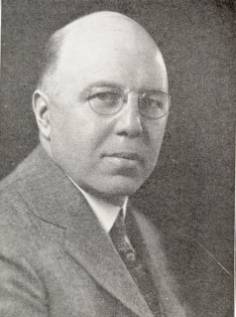 |
John W. Beaman at the age of 18 (a student at Amhurst), volunteered and was assigned to a Massachusetts Battery which served under General Banks, in the disastrous Red River (Louisiana) campaign. After the Civil War, he took up the study of Civil Engineering in Renselaer Polytechnic Institute, Troy, New York, from which he graduated. He became a member of Dr. Hayden’s party, U.S. Geological Survey and was with him two years, 1870 and 1871. This was the first exploration party sent out by the U. S. Government to survey the Yellowstone National Park area. Later he made surveys in the Indian Territory and northward in the plains states. He supervised the building of a lock and dam at Alexandria, Louisisan, on the Red River, the same river upon which he had fought as a soldier during the Civil War. From that post he was transferred to Hermann, Missouri about 1886 and two years later, he moved his headquarters to Jefferson City. At this time he was in charge of Government work on the Gasconade and Osage Rivers.
“It was during this period from 1888 to 1895,” says Doctor Beaman “that our family of three, father, mother and myself lived in Jefferson City. I entered the second grade taught by Miss Lola Murphey, whose memory is dear to my heart. During the following years, I passed through the elementary grades and those of the high school.
“When I came to Jefferson City, I was eight years old and had never attended school, because the school in Hermann was taught only in the German language, but I did go out with the principal on botanical trips, into the wooded hills around Hermann. He often captured snakes, butterflies and bugs, and I was so much impressed with the first that my stories of these adventures caused my schoolmates to nickname me ‘Snakey’. Frank Dallmeyer recently reminded me of this nickname, which time has caused to be less distasteful than when it was bestowed upon me. Nick Kielman was a ‘buddy’, who often defended me in schoolboy scraps, as one, the ‘Dutch town boys’, against the group from the eastern part of town. We lived first on Monroe Street, with Mrs. Ewing, later in an apartment over the Drug Store, opposite Lohman’s Opera House on Main Street, and finally in a new frame house on Atkinson Street, across from the Zuendt home.
“I have vivid recollections of a cyclone which tore the roof from the State Capitol Building before our startled eyes. We were living on Main Street and this could be plainly seen from our rear windows. This spectacular fire which destroyed a large flour mill and grain elevator, was seen from our home. The great political torch light processions of those days, and the barbecues where Senators Vest and Cockrell spoke, and the reception at the Governor’s Mansion to which we went to pay our respects to Governor Francis and Stone are still fresh in my memory.”
In 1895 J.W. Beaman resigned as engineer rather than supervise construction of a project he considered unsound in engineering, and the family returned to Washington, D.C. Here his son completed high school and was for a number of years assistant to U.S. Examiners of Surveys, under the General Land Office. These trips took him to many states. In 1899, he entered the Eclectic Medical Institute of Cincinnati, the second oldest Medical college in Ohio and graduated in 1903. He practiced two years in Columbus, Ohio, and one year in Dayton, and thirty-two in Cincinnati. For thirty years, he has been instructor and professor of Pediatrics and Assistant Dean and Secretary in that institution. He was president two years of the National Eclectic Medical Association, member and at present is secretary of the Bethesda Hospital Staff. For years he has been a member of the Academy of Medicine of Cincinnati, member of the Ohio Medical Association, and is active in many professional civic and fraternal organizations.
At the time of his death, J.W. Beaman was supervising the construction of a Government building for the U.S. Treasury Department at Greensboro. His widow later left Washington, D.C. to join her son and lived with his family in Cincinnati until her death May 8, 1934. “Mother had an interesting career,” says Doctor Beaman. “A few years after marriage to my father in 1874, she went with him to the Seal Islands of Alaska, being the first white American woman on these Islands. Father at that time represented the Treasury Department as Assistant Seal Agent, whose business it was to check the number of seals killed, as a bounty has to be paid the Government for each pelt. I was born shortly after my parents returned to Washington, D.C. in 1880.
- Elizabeth Louis Beaman, born October 25, 1903 (married)
- Charlotte Denise Beaman, born May 27, 1909 (married)
- Gertrude Susan Beaman, born February 14, 1913 (married)
- Charles Worchester Beaman, Jr., born July 27, 1920
- Mary Caroline Beaman, born September 2, 1924
A History of Jefferson City and Cole County, 1821-1938 By James E. Ford
Monroe P. Belch
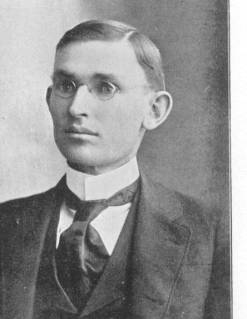 |
The father of M.P. Belch was a member of the State Senate in 1874, Speaker of the House of Representatives in 1879, as well as being a strong candidate for Congress in 1882.
In November 1895 he started practicing law at the firm of W.S. Pope, later becoming Pope & Belch, their office being in the county courthouse. He made his home at the old Belch homestead, the place of his birth, 421 East Water Street.
William Bemboom
William Bemboom was born within three and a half miles of Jefferson City, in the Frog Hollow neighborhood and came to Jefferson City at the age of seventeen, unable to speak a word of English. He was the son of John Bernard and Anna Whekamp Bemboom, both natives of Holland who married in that nation and came here prior to the Civil War. For a time J.B. Bemboom worked at Pohl’s brick yard; then on a farm near St. Thomas, where he and his wife made brick in molds by hand. In the early 1880s they came to Frog Hollow southwest of Jefferson City where he bought a tract of land, built a log cabin and reared his family.
J.B. Bemboom was a Democrat, and the first road supervisor of his district. He employed laborers at twenty-five cents per day, or seventy-five cents for a man with a team and wagon. Mr. Bemboom contracted tuberculosis and in 1891 the family returned to their old home in Holland where he died in 1893. Mrs. Bemboom died five years later. Of the ten children, five brothers and a sister died of tuberculosis.
William Bemboom attended school in Holland at Slagharen province of Overysel, until he attained the age of ten. He thereafter studied under a private tutor, specializing in agriculture, horticulture and physical culture. In 1903 he had reached the age where the laws of Holland obliged him to enter military service. After six months service which he found irksome, he exercised his rights as an American, being born in this country, to return to his native land. He came back to Jefferson City in 1904, unable to speak a word of the English language.
He worked on a farm for awhile, then learned the shoe business and worked in that business twelve years. He spent two years as an employee at the penitentiary under the Major and Gardner administrations. At this time he entered the services of the Missouri Pacific where he was fireman and locomotive engineer from 1918 to 1931. In the latter year he became a member of the police force, serving three years and seven months. He was a man of powerful physique with a determination to perform efficiently any task within his line of duty.
Mr. Bemboom was married May 12, 1908, to Miss Anna Kaufman, daughter of Fred and Annie Drexler Kaufman, natives of Switzerland and old residents of Jefferson City. Mr. Kaufman was a watchmaker by trade. They had eight children: Carrie, wife of Dean Higgins; Bernard, married Beatrice Steinmetz; and Irene, Clemens, William, Jr., Joseph, Anton and Mary Ann, all of Jefferson City.
In May and June of 1936 Mr. Bemboom visited his sister and old friends and relatives in Holland. Contrasting conditions in Holland as he remembered them as a boy with conditions here, he left well equipped with funds to entertain his old friends whom he expected to find in very modest circumstances. He found an altogether different Holland. Keeping out of the World War, that nation traded with both sides and received advantage of the high prices of that time. Many of his friends, in their fifties, had accumulated a modest fortune and retired. They insisted on entertaining him as their guest, consequently the trip cost him less than expected.
Mr. Bemboom was a skilled gardener and horticulturist, and as a hobby produced and sold more than ten thousand dollars worth of plants from the little tract of land included in the home he owned in the western part of the city.
F.H. Binder
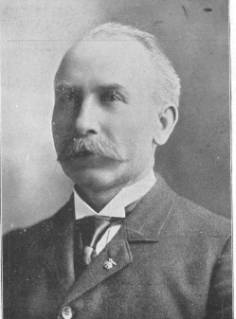 |
Mr. Binder came from a family of builders. His father, Heinrich Binder, was a practical lumber man and builder; his brother, Carl, was supervising architect of the district and city of Wolfenbuttel.
Of the marriage of Mr. Binder and Mrs. Hugerschoff came two daughters who died in infancy, and one son, Frederick C., who worked with his father and who passed away at the age of forty-four. Fred, Jr. was married to Alma Wagner, daughter of W.W. Wagner and resided at 109 West High Street.
Fred H. Binder was an active and public spirited business man. He was elected Mayor in 1884 and served on the City Council and from 1873-1883. He was instrumental in establishing the first building and loan association in Jefferson City which operated not for profit but for the up-building of the city and helped provide it with substantial homes. Mr. Binder was the President of the Jefferson City Water Works Co.; President and Manager of the Bridge and Transit Company; one of the original founders of the first Jefferson City Building and Loan Association, being its first President. He was a member of the school board and the library board, and died in 1911 at the age of sixty-six.
The results of his labor include a building at the State University, Columbia; the State Reform School, Booneville; the school and chapel at the State Deaf, Dumb, and Lunatic Asylums, Fulton; the State Industrial School for Girls, Chillicothe; the St. Peter’s and Evangelical Central Churches as well as most all the prominent businesses and residence buildings erected between the years of 1873-1892 in Jefferson City. He was also the Superintendent of Construction of the U.S. Treasury Department of which the United States Court House and Post Office, costing $150,000 was erected.
Arthur E. Blaser
Arthur E. Blaser, Hudson automobile dealer, who served for sixteen years as county collector of Cole County, was born in Jefferson City, March 30, 1886. His parents were Gotlieb and Catherine Cortvriend Blaser. Gotlieb Blaser was born at Berne, Switzerland, in 1850, coming to this country about 1867 and shortly afterwards to Cole County. Working at first as a farm laborer, he afterwards learned the butcher’s trade and owned and operated on of the first meat markets in Jefferson City. He died in 1901. His wife died in 1935 at the age of seventy-five.
Arthur Blaser was third of a family of seven children. At the age of twelve he earned money by polishing shoes. For about twelve years he was a barber. In the year 1914 he was elected collector of Cole County and served four consecutive terms in that office, from 1914 to 1930. A Republican in politics, he served as county chairman for a number of years. He established his automobile agency in 1933.
In 1907 Mr. Blaser was married to Miss Grace L. Davis, daughter of Stuart and Matilda Derkins Davis. Stuart Davis, a native of New York, died in 1928 at the age of eighty. Mrs. Davis, who was a native of Jefferson City, died about 1930. Mr. and Mrs. Blaser had two sons, Arthur E., Jr., and Raymond D.; both were associated with their father in the automobile business.
E. M. Bode
Edwin Martin Bode, an attorney and public administrator of Cole County, was born in Jefferson City January 9, 1909. His father, Benjamin Bode, was born at Westphalia about 1875, the son of Martin Bode. His mother, Susannah Schrimpf Bode, was born in Wardsville about about 1881, the daughter of Frank Schrimpf, a native of Pennsylvania. Benjamin Bode, a machinist by trade, came to Jefferson City about 1896.
E.M. Bode attended high school and junior college in Jefferson City. He then entered Cumberland University, Tennessee, from which he graduated with the degree L.L.B. in 1932. He became public administrator in 1933 and associated with the office of the county attorney. He was active in Democratic party councils of Cole County. He was married April 15, 1933, to Miss Katharine Chapman, daughter of Frank and Hattie Chapman.
Albert E. Bogg
Albert E. Bogg, better known as “Frenchie”, opened a café on Dunklin Street in 1932. He was only twenty-one years old at the time, and most older people, wiser in their own estimation, predicted that this rash and inexperienced youth who dared start a new venture at the worst period of the depression would soon be broke. “Frenchie’s” was popular from the start and Mr. Bogg’s two places at that location drew customers from all parts of the city.
A native of Newcastle, England, Mr. Bogg came to Jefferson City in 1920. His father, Charles F. Bogg, an engineer, was with the state highway department. He came to America in 1918 and prior to coming to Jefferson City was at Bridgeport, Connecticut, building submarines. During World War I he served the British government, who assigned him to engineering duties.
In 1932, Albert Bogg was married to Miss Gladys Moore, daughter of O.F. Moore, a Jefferson City resident. Mr. Moore retired from the staff of the local newspaper and moved to Denver at the home for printers maintained by the typographical union of which he had long been a member. His wife died around 1918. Albert and Gladys Bogg had a son, Albert Lee, born October 14, 1934.
Otto P. Bohn
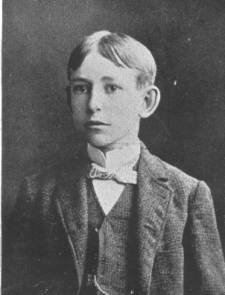 |
At the age of 11, being advised by his physician to have some outdoor exercise or employment, and anxious to begin his life work, he began to carry city papers, first for Miss Maggie Miller and later adding to his duties the work of distributing the Press and State Tribune. He was a most consistent, conscientious and duty-loving member of the Presbyterian Church, with which he united without any advice or suggestion from his parents. He was also a member and active worker of the Young People’s Society of Christian Endeavor and a regular attendant at Sunday school.
As a student at school, his bright and respective mind enabled him to keep in advance of his class with apparent slight application. He would have graduated next year with honors and was looking forward to a course at the State University, which he felt would help him climb the ladder to excellence in the literary and scientific world.
His death occurred at 12:10 pm while en-route from school to his home, the result of heart failure. The school dismissed in deference to his memory and attended his funeral at the Presbyterian Church, preached by Dr. J.F. Hendy. His remains were accompanied by his parents, brother and sister to Centralia, Illinois where he now rests.
He had a bright mind, impelled by an ambitious desire to make something of himself, with a disposition and make-up that made of him a character of which contemplation drew forth admiration for one who had such a bright promise of success; while his warm and tender heart was such that all were drawn to him with a feeling of affection rarely associated with a boy. His sudden death produced a keen sorrow in the hearts of all his admiring friends while with his family, who knew him better, it was a dark shadow which Time, the great healer, is converting into a sweet memory, the recalling of which affords to them a sacred and refined pleasure.
Emmett Scott Bond
Emmett S. Bond was elected presiding judge of Cole County in November, 1934. He was born near Russellville October 15, 1874, the son of William and Leona Scott Bond, who were also born in Cole County. The father was of English descent and a successful farmer and stockman as well as a merchant at Russellville for many years. The mother was the daughter of Thomas Jefferson and Mary Jane Scott who migrated from Kentucky and Tennessee at an early date. Thomas Jefferson Scott was one of the leading farmers and active in the business enterprises of the community in which he lived.
After completing the course of the elementary schools of the county, Judge Bond attended the then widely known Hooper Institute at Clarksburg. From 1891 to 1901 he taught in Cole and Moniteau Counties, meanwhile farming on the old homestead. In 1901 he entered the lumber business at St. James, Missouri, in association with James R. Proctor, under the firm name of Bond and Proctor which continued operations for a number of years, owning lumber yards at various locations throughout the state until 1918. For about a year thereafter he engaged in lead and zinc mining at Picher, Oklahoma. He also served as cashier of the First State Bank of Picher, owning a third interest in the institution which he later sold. He was active in the wholesale lumber business and in the manufacture of pine products at Muskogee, Oklahoma, for a period of two years and was owner of lumber mills in Louisiana, Arkansas and Texas. Eventually he turned his attention to the oil drilling and producing business in Texarkana, Texas. Later moving to Kansas City, he engaged in the real estate business for several years.
In 1926 he returned to the old homestead farm at Russellville. He became president of the Cole County Corn and Hog Association in 1934 and remained at its head until he became presiding judge.
By his first wife whom he married in Moniteau County, Judge Bond had a son, Eldred S. Bond, a resident of Kansas City who married Genevieve Connor and had a daughter, Ann. On October 24, 1931, in Kirksville, Missouri Judge Bond married again, to Miss Margaret Speiser of Greencastle, Missouri. Mrs. Bond held a life certificate from the state teachers’ college at Kirksville and taught several terms of school, six terms in the Russellville Consolidated District. She was an officer of the Eastern Star in Russellville and a member of the Methodist Church.
Judge Bond was active in the Democratic Party. He was formerly a member of the school board and served as chairman of various county drought relief committees. Shortly after he became presiding judge he was elected president of the Missouri Good Roads Association. In September, 1936, he was elected president of the Missouri Judges Association. In the primary of August, 1938, Judge Bond was re-nominated for a second term as presiding judge.
Otto C. Botz
Otto C. Botz, was owner of the mammoth Missouri State Chickeries of Jefferson City and directing head of a number of industries and corporations. He was born in St. Louis, October 20, 1881, the son of Charles J. and Elizabeth Mueller Botz, natives of Baden Germany. His paternal grandfather was Joseph Botz.
Joseph Botz was a descendant of a French soldier in the army of Napoleon who survived the Moscow expedition but settled in Germany instead of returning to France. Joseph Botz was active in the liberal movement in Germany in the 1840s and for that was banished, joining other distinguished and courageous men, including Carl Schurz, in coming to America in 1848. Bismarck later secured an order restoring the rights of those who participated in this attempt to liberalize the German government, and Joseph Botz returned to his native land and resumed his German citizenship.
By his father’s resumption of German citizenship, Charles J. Botz, who returned with this father to Germany, became automatically a German citizen. In 1874, he officially renounced his German citizenship and later became a citizen of this country through naturalization. Charles J. Botz while living in St. Louis learned the printer’s trade under Carl Schurz. For a short time he conducted a German newspaper at California, Missouri, then, in 1881, returned to St. Louis. From there he went to Sedalia the following year, becoming one of the owners of the Sedalia Journal of which he was editor from 1882 to 1917. The Journal attained prestige and profit under his administration.
Otto C. Botz was six months old when his parents moved to Sedalia. Growing up in a newspaper office, he naturally became interested in the business and in 1900 secured an interest in his father’s business and became business manager of the Journal. In 1902, for the value of the experience, he planned a world tour in which he should work his way. On this tour he was in Europe when the Russo-Japanese War broke out, so he did not go to the Orient as he had planned. At the end of 22 months and working in 35 states in America and 13 foreign countries, returning to Sedalia he became the managing head of the Botz & Sons Printing and Stationery Company, consisting of Charles J. Botz and his four sons, becoming nationally known as “the printers five”.
In March, 1921, this company purchased the Paul Hunt Stationery Store in Jefferson City to better conduct the State of Missouri Stationery contract they had secured at the beginning of the Gardner administration in 1917. In July of the same year, they organized the Jefferson City Printing Co., and in September the Art Shop. In October of the same year, all of these companies were merged into one corporation, purchasing the Hugh Stephens Printing Co. of which Otto G. Botz became President and General Manager. He was successful in building the new corporation operated as the Hugh Stephens Printing & Stationery Co., into one of the best equipped printing and stationery plants in the United States, specializing in college annual work (taking a big majority of all national prizes in this field), seed and nursery catalogs, county and bank work, and holding the State of Missouri printing, binding and stationery contracts as well as doing a general commercial printing, publishing and stationery business.
After the election of 1932, a group of local Democratic politicians, with the support of the newly elected members of the Printing Commission of the state of Missouri, saw fit to consider the state contracts as political patronage, whereupon after several months of harassing and pressure, the Botz Printing & Stationery Company (to which name the old Hugh Stephens Printing & Stationery Co. had been changed in 1928), sold its physical assets together with the retail office supply store and retired from active work in this field for a period of five yers, maintaining however its corporate structure, becoming a part of the Botz Industries. This later organization operated under the guiding hand of Otto C. Botz, the Botz Printing & Stationery Co., the Botz Real Estate and Investment Co., the Missouri State Chickeries, the Capitol Poultry Farms and the Panorama Nursery Corporation, all located in Jefferson City.
Otto C. Botz was also the inventor of “The Botz Quick Freezing Process,” holding patents on the last word in frozen dressed poultry.
Mr. Botz was married in June 1918 to Renee Odette Bichet, born and reared in Paris, France, where he had met her during his travels in 1903, she being the first French girl permitted to come to America during World War I. They were married in St. Louis, MO, where Mr. Botz was born, first moving to Sedalia, MO then later to Villa Panorama, Jefferson City. They had no children.
C. S. Boyd
Boyd’s Bakery was established in 1933 when C.S. Boyd bought the bakery hitherto conducted by Mrs. Gilliland on High Street. The business was continued at the same location following extensive refurbishing. Three trucks were employed to supply the Jefferson City trade with bakery products.
Mr. Boyd was born and reared at Fort Scott, Kansas, where he ran a bakery for ten years. He spent five years west of Dodge City in the dust bowl area. Born around 1895, he was the son of Daniel and Ida Hood Boyd who lived at Fort Scott. Daniel Boyd was a baker by occupation and C.S. had the opportunity to learn the business in his boyhood and bought a bakery of his own at the age of nineteen.
Mr. Boyd was married in 1926 to Miss Clara Ruth Swillum, a native of Moniteau County, daughter of the late John Swillum of the city of California. Mrs. Boyd assisted her husband in the management of the business.
J.H. Bredeman
John H. Bredeman was born in Nord Borchen, near Paderborn, Province of Westphalia, Germany on June 8, 1849, where attended school under his father, who was a teacher, until the age of 14. In 1867 he graduated from the Mechanical School of Paderborn, having determined to make blacksmithing his business. That same year he immigrated to America, coming directly to Jefferson City with his uncle, Joseph Knaup.
From 1868-1869 he worked as a blacksmith under Fred Fisher, John Fitzpatrick and Henry Dimler. In 1869 he formed a partnership with Joseph Crump and they opened a blacksmith shop, buying out his partner’s interest one year later. He continued his business for the next five years, then selling out and becoming a foreman in the saddletree shop of J.S. Sullivan at the Missouri Penitentiary, a position which he held for the next 10 years. He was then elected as Assistant in the Industrial Department of Lincoln Institute, later becoming Superintendent in 1899.
Mr. Bredeman was married on June 9, 1870 to Theresa Schrimpf of which 17 children were born, two dying in infancy. The children are as follows: Kate who married Ben Droste of Jefferson City; Anna who married John W. Grieshammer of Jefferson City; John who lived in St. Louis and worked for the Hamilton-Brown Shoe Company; Lawrence who was an assistant foreman at the Giesecke Shoe Company; Frank who was a druggist at J.L. Wright, Jefferson City; Albert was a US soldier living in the Philippines at the time of this writing; and Mary, Lizzie, Clara, George, Edward, Pauline, Lavenia, Herman, and Henry were all still living at home at the time this was written. Mr. Bredeman was a member of the St. Peter’s Catholic Church; Catholic Knights of America and a Democrat. He, along with his large family, made their home at 123 East McCarty Street.
F.M. Brown
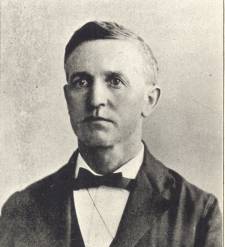 |
In January, 1885 he was appointed Reporter of the Supreme Court of Missouri, a position which he held until July 14, 1897. Also in January, 1885 he formed a partnership with Edwin Silver, the firm name being Siler & Brown, later of which became Smith, Silver & Brown after the addition of Judge Jackson L. Smith in July, 1887.
Mr. Brown married on May 15, 1880 Bettie D. French of Mexico, Missouri, daughter of William L. and Eliza J. French. To this union seven children were born: Mary, Linn F., Rose, Paul M., William F., as well as Floyd F. and Frances, who died in infancy. His elegant home and interesting family lived at 903 Jackson Street in the south suburbs of the city.
Dr. J.G. Bruce
Dr. J.G. Bruce was a native of Nova Scotia where he was born June 16, 1886. His father, Henry H. Bruce, was the son of George Bruce, a Scottish Highlander who emigrated to Nova Scotia. Doctor Bruce was educated in Nova Scotia. He was gold medalist from Picton Academy after which he studied in Dalhouse University where he received an A.B. degree and also graduated in medicine, being president of his class in the final year.
He was quarterback on the Dalhouse football team, champions of eastern Canada for ten years. He was president of the Cole county Medical Society in 1927 and again in 1938. In 1924 he was president of the Callaway County Medical Society.
Following his graduation in medicine, Dr. Bruce was interne and house surgeon for two years in Bellevue and St. Vincent Hospitals, New York City, following which he returned to Nova Scotia for the practice of medicine. In 1924 he came to Fulton, Missouri where he remained for two years, locating in Jefferson City in 1926.
Doctor Bruce was married in 1924 to Miss Maude Macleod, daughter of Murdock and Christine Macleod of Nova Scotia. They had two children, Shirley and Nancy. Doctor Bruce had a son by a former marriage, the Reverend Garfield Bruce of St. John, New Brunswick.
Larry Brunk
Larry Brunk, the son of Henry Clay and Martha Ellen (Hamilton) Brunk, was born on a farm in Franklin County, February 9, 1883. His paternal grandfather, James Brunk, moved from Kentucky to a Franklin County farm in the 1840s. Larry Brunk attended the Aurora public schools, after which he worked in the lead and zinc mines there, later becoming a mine superintendent and operator. HE was married February 1, 1918, to Miss Anna Urschel of West Plains. Their son, Larry Urschel was born January 8, 1921.
Mr. Brunk was recognized as one of Missouri’s Republican leaders. His first political experience was four terms as mayor of the city of Aurora. Following this, in 1922, he was elected to the state senate from the eighteenth district, and was re-elected in 1926. In November, 1926 Mr. Brunk was appointed secretary of the Workmen’s Compensation Commission. Prior to this time he served as secretary to the Public Service Commission. From 1929 to 1933 Mr. Brunk was state treasurer. He later became involved in the automobile business and was interested in mining activities.
John H. Bruner
John Herbert Bruner, former chief of police of Jefferson City, was born in this city May 12, 1899. He was killed while making a trip to Kansas City in the course of duty early in Janury, 1937, being accidentally struck by an automobile on the highway near Lee’s Summit.
Mr. Bruner was a senior in high school when this country entered World War I. He promptly entered military service and his high school diploma was given him after his return from the war. He enlisted in Company L, made up of Jefferson City boys, and afterwards became a member of Company C, One Hundred Thirtieth Machine Gun Corps. He served in the major drives including the Argonne, and St. Mihiel, was gassed, and received the Congressional medal for gallantry in action.
On his return from the war, Mr. Bruner entered the service of the Missouri Pacific as brakeman, being promoted to conductor in 1929. This position he held until he resigned in 1932 to become chief of police, an office he was holding at the time of his death. In 1921 he married Miss Ella May Adams, a native of Vernon County, daughter of Mr. and Mrs. C.R. Adams. He left two sons, Charles Herbert and John Robert. Mr. Bruner was a member of the Christian Church and a leader of the Democratic party.
John Bruner was the son of the late John William Bruner, for many years constable of this township. J.W. bruner was born in Estill County, Kentucky, in 1861, the son of John Bruner. He was a miner in early life, coming to Carrollton, Missouri in the early 1880s and for five years he was deputy sheriff of Carroll County. In 1886 he came to Jefferson City as prison guard during the administration of Governor John S. Marmaduke, and after conspicuous service for thirty-five years he resigned to become township constable. He was married at Carrollton in 1884 to Alice Adams, a native of Estill County, Kentucky and a childhood acquaintance. HE died May 12, 1931. John H. Bruner was their only son.
Louis Brunner
Louis Brunner, Jefferson City contractor, was born in Austria in August, 1883. His father, John Brunner, was killed in the explosion of a powder magazine when Louis was three years old. Louis remained in Austria with his mother, two brothers and a sister, until he was seventeen years old when he came to America in company with George Pope who was a neighbor of the family before coming to this country. Mr. Brunner’s mother died in Austria around 1934. A brother who held the rank of captain in World War I was killed in that war. His older brother and his sister remained in Austria.
On coming to Jefferson City at the age of seventeen, Mr. Brunner worked on a farm for about a year until he could become familiar with our language. He then worked for Mr. Pope for about fourteen years. For eleven years of this time he was foreman. This was in concrete work, in railroad construction work, and in various construction activities.
Around 1915 Mr. Brunner went into the general contracting business for himself. While most of his business was in Jefferson City, he covered an area within a hundred mile radius of Jefferson City.
In 1913 Mr. Brunner was married to Miss Margaret E. Antweiler, daughter of Jacob and Margaret Honey Antweiler. Jacob Antweiler, who died in 1918 at the age of seventy-five, came to America at the age of ten. He served in the Union Army in the Civil War. His wife died at the age of forty-two. Mr. and Mrs. Brunner had six children. Alvin, born September 5, 1813, was associated with his father in the contracting business. Paul, born March 1, 1917, also helped in that business. Leonard was born December 16, 1918; Florence, on February 20, 1921; and Dorothy and Dolores, twins, on March 7, 1927. The family was members of the Catholic Church. Mr. Brunner belonged to the Knights of Columbus and the St. Peter’s Benevolent Society.
Dr. Bernard Bruns
Doctor Bernard Bruns, eminent pioneer physician and citizen, was born in Hanover, December 24, 1801. He graduated at the University of Bonn, after which he studied medicine at Berlin, graduating in medicine in 1829. At Berlin he was in contact with the intellectual leaders of Germany, among them being Alexander Von Humboldt, famous traveler and scientist. On graduating he settled in Westphalia for the practice of medicine.
In 1832 he came to St. Louis where he met Nicholas Hesse, adventurer and writer, and came with him to Osage County where he bought government land and contracted for the erection of a house, then returned to Germany. In 1835 he came with a small colony and founded the town of Westphalia, entertaining many famous visitors in the home he built there. He continued the practice of medicine until 1856 when he moved to Jefferson City where he remained until he died of illness, April 1, 1864. Dr. Bruns was mayor of Jefferson City at the time of his death. For some time he conducted a mercantile business here.
On May 4, 1832, before coming to America, Dr Bruns married Henrietta Geisberg who was born at Stromberg, Westphalia, October 28, 1813, and who died in Jefferson City November 7, 1899. She was the daughter of Maximilian Geisberg, chief of forestry and chase for the province of Westphlia, whose paternal ancestry is traced to Johan Georg Geisberg, 1601-1651. The children of Doctor and Mrs. Bruns included Herman and Henry Bruns, Mrs. Effie Decker and Mrs. Ottilie Hess, Louis and William. Captain Henry Bruns was the first Jefferson Citian killed in the Civil War. Herman Bruns, born in Germany, educted in Westphalia and Jefferson City, was associated with his father in the mercantile business. He was a leader in political and civic activities of the city and county.
J. B. Bruns
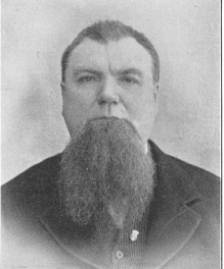 |
In April of 1868 he removed to Jefferson City, working in the brickyards but after a year he returned to St. Louis. On August 30, 1869 he married Mary Yunck, widow of Bernard Yunck, near Taos, Cole County. Assuming charge of his wife’s farm, he remained a while and then sold it, moving to Jefferson City, again making wooden shoes. In 1873 he was appointed Street Commissioner of Jefferson City. He and his wife purchased their first property in Jefferson City and started a small dry goods and grocery store. Mary attended the details of this business while her husband performed the duties of his office.
In 1880 the Bruns’ were able to add onto their three-room dwelling and increase their business, later purchasing the corner lot and erecting their beautiful store building and residence. In the fall of 1880 Mr. Bruns was elected County Treasurer on the Democratic ticket, and was elected a second term. In May 1894, he and others organized a company for the purpose of manufacturing shoes under the name of J.B. Bruns Shoe Company.
The Bruns’ had three children: Lena who married George Knollmeyer; Anna; and J. Herman Bruns who married Mary Dulle, the daughter of Judge Henry Dulle of Jefferson City. The family resided at 200 Broadway.
Fred Buehrle
Fredolin Buehrle, son of Mr. and Mrs. Wendeln Buehrle, was born in Jefferson City January 31, 1860. His father, a native of Baden, Germany, came to Jefferson City in 1858 from Fort Wayne, Indiana. In Germany in the 1840s he served under Siegel in the revolt against a despotic government, and was obliged to leave Germany as were many others who became leading citizens of America. He was a potter by trade and worked at that trade at Fort Wayne. He also did plastering, bricklaying, and was a contractor in the erection of brick buildings. At Fort Wayne he met and married Margaret Bodtenschats, a native of Bavaria, and their first child was born there.
Shortly after he went into business for himself his house burned, destroying all his possessions. Soon thereafter he came with his family to Jefferson City which was his home for the remainder of his life. He was a union soldier, serving in the Home Guards in the Civil War. Wendeln Buehrle died in 1914 at the age if eighty-seven, his wife in 1872.
Fred, the third child of Wendeln and Margaret Buehrle, clerked at various stores of Jefferson City in his youth, including the Schultz and Wells establishments. He also assisted his father, worked at whitewashing, hod carrying, etc. At the age of twenty he went to St. Louis where in1880 and 1881 he drove a huckster wagon for five dollars a month, board and washing. There he cast his first vote, returning to Jefferson City in 1881 he began work as a bricklayer, soon becoming one of the most efficient in the country.
He worked under Frank Miller, then a brick contractor and architect, and an enduring friendship developed between the two. Among the buildings on which Mr. Buehrle laid brick in 1881 were the Dallmeyer and Linhardt buildings. In 1882, while he was helping Mr. Miller who had under construction a union depot at Pacific, Mr. Miller was hurt in an accident. Following this accident Mr. Buehrle assumed charge of and completed the contract for the Robertson building in Jefferson City. Following this, Mr. Miller secured a contract for a brick stockade part way around the prison grounds. As he was obliged to be away from the city on other business, Mr. Buehrle as foreman completed the contract for erecting this brick wall. Thenceforth he was engaged chiefly in the brick contracting business.
No one has done more in the actual construction of Jefferson City buildings than has Mr. Buehrle. Among the buildings he erected are the Lohman Opera House, the Carnegie Library, dormitories at Lincoln Institute, a twenty-stall roundhouse for the Missouri Pacific, the Episcopal and the Methodist Churches, and a five-story addition to the Madison Hotel. He built the Hardin College Chapel, the Guitar building at Columbia and the trust building at Mexico. For more than a year he was foreman in the construction of the wings on the old state capitol in 1887-1888, resigning to join Mr. Miller in some of the latter’s construction work.
In 1908 Mr. Buehrle bought and moved to a farm southwest of Jefferson City. May 16, 1883, he married Bertha M. Langerhans, daughter of Henry L. and Henrietta and sister of the Rev. Chris L. Langerhans. She was a native of this city and died September 12, 1930, after forty-seven years of married life.
Eleven children were born to Mr. and Mrs. Buehrle, three of who died in childhood, two being buried in one grave in one day. Bertha K. is the wife of Eugene Pithoff of the Midland Printing Company. Fred L. died in 1924 from the effects of being gassed in World War I. Henry A., Jefferson City grocer, married Sadie, daughter of James Handley. Laura K. married G. Vieth. Albert W. lived on the farm with his father. William was a Jefferson City carpenter. He married Lorene Block. Louise was the wife of Lois Stein and Hilda of Sylvester Boehm.
Mr. Buehrle’s interests were in his business and farm rather than in politics. However, he served four years on the city council within which time the first real start was made toward building improved streets. He once made the race for presiding judge of the county court, missing election by about forty votes.
O.E. Burch
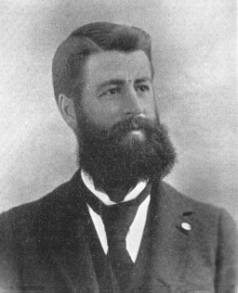 |
Recovering his health, he returned to Jefferson City in November 1894 where he organized the Burch-Berendzen Grocer Co. He was united in marriage to Bessie Hope, daughter of George Hope, Sr., on June 17, 1897. Mr. Burch was an active member of the Presbyterian Church, of which he was a deacon, as well as being a stockholder in the First National Bank of Los Angeles. His home was at 111 East Miller Street.
O.G. Burch
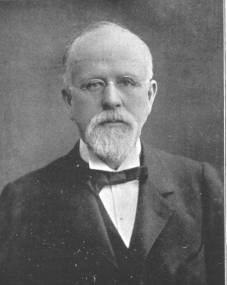 |
On August 15, 1862 he enlisted in the 19th Iowa Infantry Volunteers Co. A, under Captain John Bruce. He was actively engaged in the field at the battle of Prairie Grove, Arkansas on December 7, 1862; the siege and surrender of Vicksburg in July 1863; and was a prisoner of war from September 29, 1863 through July 22, 1864. He was a member of an expedition against Mobile in East Pascagoula in January 1865 and in the siege and capture of the Spanish Fort and the adjacent works in April of that same year. In 1864 he was commissioned Lieutenant of Co. G and was then made Sergeant Major at Prairie Grove, Arkansas, when Colonel McFarland was killed. He was honorably discharged at Mobile, Alabama on July 10, 1865 and was mustered out of service at Davenport, Iowa on July 31st of the same year.
Mr. Burch came to Jefferson City in August 1865 where he was appointed assistant State Librarian. He was then made deputy under his brother, Nelson C. Burch, who was clerk of the Supreme Court under the administration of Governor Thomas C. Fletcher. Upon expiration of his term, he engaged in the real estate and insurance business with two of his sons, Nelson C. and Edson.
Mr. Burch was associate editor of the State Journal, a daily and weekly Republican paper of which was the first daily paper regularly published in Jefferson City. He was also reporter and correspondent for the St. Louis Globe-Democrat for many years. He was elected city assessor of Jefferson City one term and was then postmaster under President Hayes from 1877-1881 and continued until the death of President Garfield, all the while being actively engaged in his real estate and insurance business. In August 1882 he was made book keeper of the First National Bank and continued this position until August 1, 1884 when he was made cashier.
Mr. Burch was united in marriage in Catlettsburg, Kentucky on March 22, 1866 to Mary E. Hart of Keokuk, Iowa. To this union five children were born: O.E. Burch; Nelson C.; Edson L.; Edith; and Asenath. Mr. Burch was a direct descendent of a brother and a co-patriot of General Nathanial Green of Revolutionary fame. Mrs. Burch’s ancestors on her father’s side were closely related to Israel Putnam, another prominent figure in the Revolutionary War.
Mr. Burch was a member of G.A.R.; a Republican and an active member of the Presbyterian Church, being Superintendent of the Sunday School for many years. He was a member of the Board of Regents of Lincoln Institute for 14 years and was Treasurer of the Jefferson City Building and Loan Association of which he was a charter director. He resided at 904 Jefferson Street.
A. M. Burkel
A. M. Burkel, veteran shoe merchant of Jefferson City, learned the shoemaker’s trade in Germany where he was born. In 1884, at the age of seventeen, he came to America and to Jefferson City. He worked on a farm for a few months only, and in the fall of 1884 began work for the Church shoe store at which he continued eighteen years.
July 29, 1902, Mr. Burkel in partnership with Herman Bosch opened the Burkel & Bosch shoe store for business in the location formerly occupied by the Hanszen store. This was shortly after the death of Mr. Hanszen. Mr. Bosch died about 1930 and his interest was taken over by Mr. Burkel and his son, L.A. Burkel, who became sole owners.
In 1889 Mr. Burkel was married to Miss Anna Gipfert, a native of Jefferson City whose father was a Union soldier in the Civil War. They had three children: L. A., Carl and Elsie. L. A. married Margaret Bassman of a well known Jefferson City family. They had three children: L.A., Jr., Marjorie and Frederick. Carl, a carpenter by trade and a resident of this city, married Blanche Petry, a Jefferson City girl. They too had three children, Ruth Catherine, Carl Edward and Donald Lee. Miss Elsie was still living at home in 1938.
Mr. Burkel was a member of the Knights of Pythias and Knights of the Maccabees. The Burkel family was members of the Evangelical Church.
T.G. Burkhardt
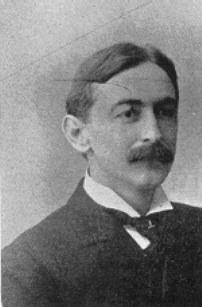 |
In 1888 he returned from Europe spending one year in Chicago at a prominent jeweler on State Street and then removed in 1889 to St. Paul and finally in 1890 moved to Jefferson City, opening a jewelry store on October 7, 1890, in the City Hotel building. In 1898 he moved his business to the Realty Building.
He married Frances Summers, daughter of Captain W.T. Summers, a prominent live stock man of Centralia, on November 17, 1897. Mr. Burkhardt was a member of the Evangelical Central Church and the A.F. & A.M. He and his wife lived with a Mrs. Woodrum at 419 East High Street.
Hugo Busch
Hugo Busch was born in Germany at the close of the year 1866. From childhood he was a lover of flowers and by the time he was fifteen years old was an expert in their cultivation. Coming to America with an uncle while yet a boy, Mr. Busch worked several years for a floral concern in St. Louis and for a shorter time in Kansas City.
In 1890 he bought out the Nagel Florists, located at Madison and Dunklin. This was a small concern, with about 800 feet of glass, and Mr. Busch for a time found one assistant to be adequate help. He began a conservative and gradual program of enlargement and by 1938 had one of the largest establishments of the kind in central Missouri with eight large greenhouses, fifty thousand feet of glass, and sixteen acres of ground devoted to flower and plant development. Two of the greenhouses were connected with the offices at Madison and Dunklin streets, the others on Highway 50 just west of the city.
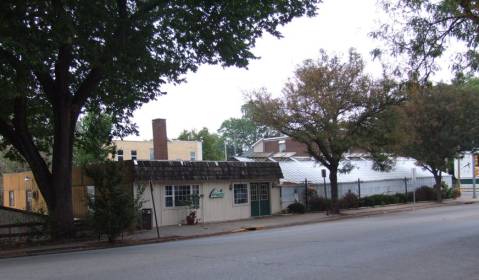
Busch’s Florist, 2006
Mr. Busch was married on January 14, 1891, to Miss Lena Young, who passed away in February 1935, leaving eight sons and two daughters. All but two of the sons were associated with their father in business. Otto, the second son, operated a summer resort on the Osage River, and Harold, the youngest, was with the Central Missouri Trust Company. His other sons were Hugo (the oldest), Walter, Theodore and Bobby. One daughter married Paul Wishmeier, a Jefferson City shoe merchant. The other, Marie, who lost her sight at the age of twenty-one, had an enviable record of service as a teacher of the blind and lived in Kirkwood in charge of care and education of the blind over a district comprising a number of counties.
Mr. Busch was an active member of the Lutheran Church. He was a member of the board of directors of the chamber of commerce, and a member of the Rotary Club. While always interested in civic and governmental affairs, he made it a rule to avoid seeking office, though he was elected and served as a member of the city council.


